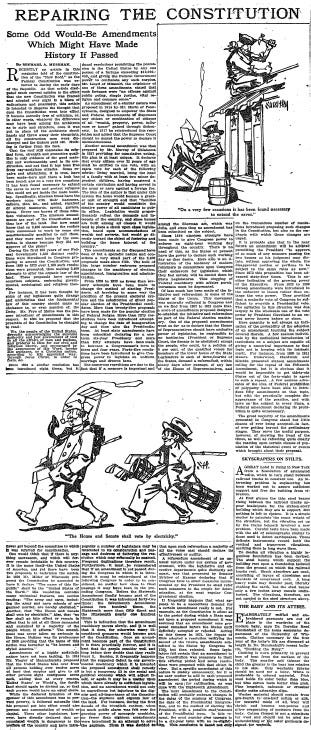Repairing the Constitution
A 1923 New York Times Magazine article highlighted the most unusual constitutional amendment proposals from the prior decade or so, including:
Rep. James Tilghman Lloyd of Missouri's amendment banning any American from possessing a net worth above $10 million, or about $177 million in 2023 dollars.
Even today's most left-leaning members of Congress, like Alexandria Ocasio-Cortez and Bernie Sanders, want to increase taxes on the rich, but I'm unaware of any proposals to institute an actual wealth maximum?
1917: William H. Murray of Oklahoma's amendment giving citizens extra votes for any of several various attributes, including being married, having at least two minor children, or having served in the military during wartime.
A modern variant is Republican presidential candidate Vivek Ramaswamy's proposal to raise the minimum voting age from 18 to 25, unless an 18-to-24-year-old has completed one of several various life accomplishments, including serving in the military.
1914: Rep. John Morin of Pennsylvania's amendment allowing the government to claw back any person's "wealth, property, power, influence, or honor" obtained through dishonesty.
Wealth, property, or power seem within the government's power to take away — at least "official" power such as elected office — but how would they take away influence or honor?
The 1923 article also accurately predicted the general topic of the next constitutional amendment which would be successfully ratified, though it got one major detail wrong.
"The next amendment to the Constitution will probably embrace changes in the dates of the sessions of Congress, the date of the presidential inauguration, and in the method of electing the president, with a possible readjustment of the presidential term."
Indeed, the 20th Amendment was the next one ratified, in 1933. It moved the start of each new Congress from March 4 to January 3, and the start of each new presidential term from March 4 to January 20.
However, this prediction about another change to the presidency was definitely wrong:
"In this respect, the most popular plea appears to be a six-year term with no re-eligibility. This conclusion is based not only on the tremendous number of resolutions introduced proposing such changes in the Constitution, but also on the emphasis with which these changes are urged."
Instead, the presidency remains a four-year term with re-eligibility. The Twenty-Second Amendment, ratified in 1951 after Franklin D. Roosevelt's election to four terms, would cap the presidency at two terms.
For my job writing about Congress at GovTrack Insider, I've covered several constitutional amendments introduced so far in 2023, including:
A Republican amendment from Rep. Tom McClintock (R-CA5) to give the president a line-item veto over federal spending — even though Joe Biden’s a Democrat.
An amendment from Rep. Sean Casten (D-IL6) to add 12 more senators who would be "nationwide" instead of serving a specific state, elected by ranked choice voting.
An amendment from Rep. Kevin Kiley (R-CA3) to ban state governors from filling a U.S. Senate vacancy. Just since I wrote that article in May, the situation has come up, as California Gov. Gavin Newsom appointed Laphonza Butler to fill the vacancy left by Dianne Feinstein's death.
An amendment from Rep. John James (R-MI10) to set a maximum age limit of 75 for president, vice president, and members of Congress. (Even though Rep. James has endorsed Donald Trump for 2024, despite his being older than 75.)
Repairing the Constitution
Published: Sunday, October 7, 1923


